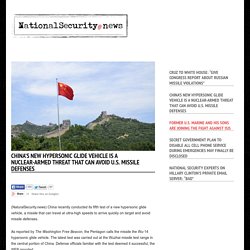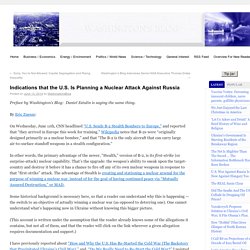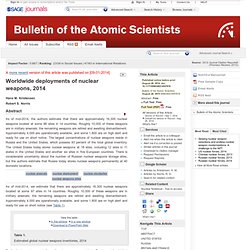

China’s new hypersonic glide vehicle is a nuclear-armed threat that can avoid U.S. missile defenses. (NaturalSecurity.news) China recently conducted its fifth test of a new hypersonic glide vehicle, a missile that can travel at ultra-high speeds to arrive quickly on target and avoid missile defenses.

As reported by The Washington Free Beacon, the Pentagon calls the missile the Wu-14 hypersonic glide vehicle. The latest test was carried out at the Wuzhai missile test range in the central portion of China. Defense officials familiar with the test deemed it successful, the WFB reported. Also, American defense officials said the vehicle, which speeds along the edge of the earth’s atmosphere, demonstrated a new capability during the latest test: that it was able to take evasive actions. U.S. intelligence officials have been tracking the testing and development of the Wu-14 for more than a year and, as such, have obtained valuable insights into the potential weapon.
3 U.S. Nuclear War Labs Should Be Shut. NEW YORK---The nation's three privatized nuclear warhead laboratories are bloated, redundant, stand in the way of progress on real 21st century security issues, and should be shut down, a conference on peace and security here was told.

"These privatized labs have become a considerable racket" and this year will consume more than $4 billion for their nuclear weapons activities, said Greg Mello, Executive Director of the Los Alamos Study Group (LASG), of Albuquerque, N.M., which tracks their activities. The laboratories are the Los Alamos National Laboratory (LANL) in Los Alamos, N.M., the Sandia National Laboratories (SNL) in Albuquerque, NM, and the Lawrence Livermore National Laboratory (LLNL) in Livermore, CA. Civil society's disarmament's efforts since the demise of the Soviet Union "have all foundered in substantial part because they failed to realize the central importance of attenuating and then eliminating the political power of these laboratories," Mello said.
Indications that the U.S. Is Planning a Nuclear Attack Against Russia Washington's Blog. Preface by Washington’s Blog: Daniel Estulin is saying the same thing.

By Eric Zuesse: On Wednesday, June 11th, CNN headlined “U.S. Sends B-2 Stealth Bombers to Europe,” and reported that “they arrived in Europe this week for training.” Wikipedia notes that B-2s were “originally designed primarily as a nuclear bomber,” and that “The B-2 is the only aircraft that can carry large air-to-surface standoff weapons in a stealth configuration.” In other words, the primary advantage of the newer, “Stealth,” version of B-2, is its first-strike (or surprise-attack) nuclear capability. Some historical background is necessary here, so that a reader can understand why this is happening — the switch to an objective of actually winning a nuclear war (as opposed to deterring one). I have previously reported about “How and Why the U.S. Consequently, for example, a recent CNN Poll has found that Americans’ fear of Russia has soared within just the past two years.
U.S. Ramping Up Major Renewal in Nuclear Arms. Worldwide deployments of nuclear weapons, 2014. Abstract As of mid-2014, the authors estimate that there are approximately 16,300 nuclear weapons located at some 98 sites in 14 countries.

Roughly 10,000 of these weapons are in military arsenals; the remaining weapons are retired and awaiting dismantlement. Approximately 4,000 are operationally available, and some 1,800 are on high alert and ready for use on short notice. The largest concentrations of nuclear weapons reside in Russia and the United States, which possess 93 percent of the total global inventory. The United States today stores nuclear weapons at 18 sites, including 12 sites in 11 states in the United States and another six sites in five European countries. As of mid-2014, we estimate that there are approximately 16,300 nuclear weapons located at some 97 sites in 14 countries. Table 1. Estimated global nuclear weapons inventories, 2014 United States Since our previous estimate in 2009, the United States has further consolidated its nuclear weapons into fewer sites.
Russia.